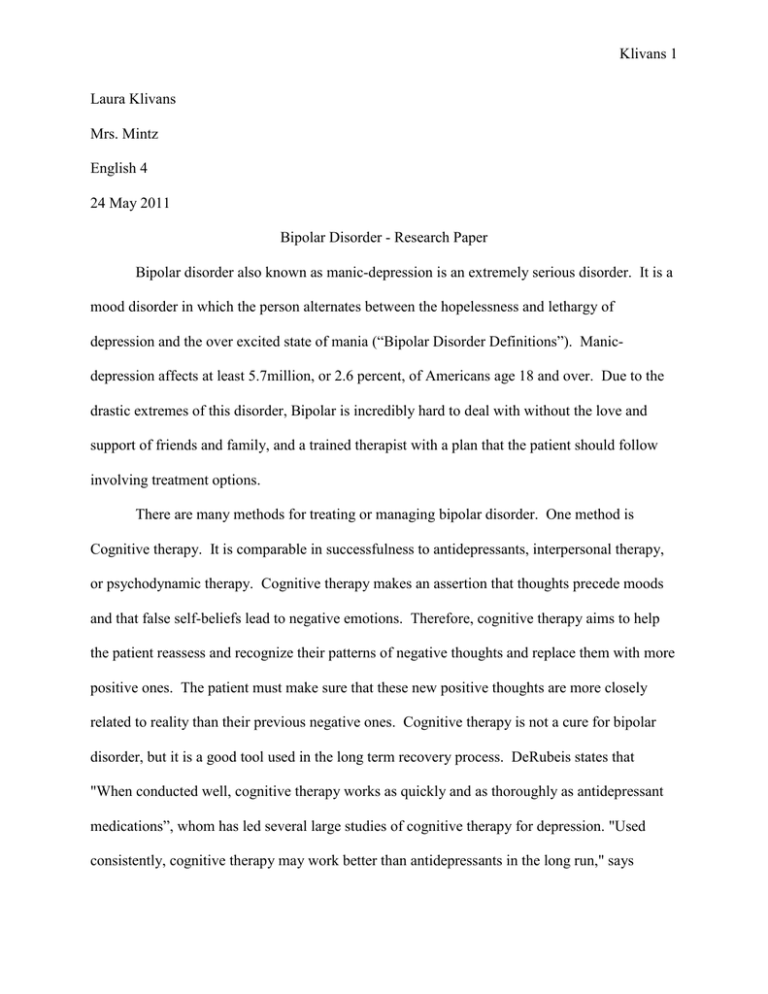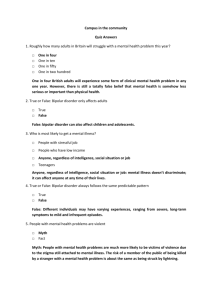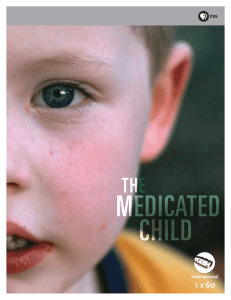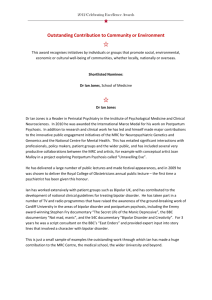File - Mrs. Mintz's Website
advertisement

Klivans 1 Laura Klivans Mrs. Mintz English 4 24 May 2011 Bipolar Disorder - Research Paper Bipolar disorder also known as manic-depression is an extremely serious disorder. It is a mood disorder in which the person alternates between the hopelessness and lethargy of depression and the over excited state of mania (“Bipolar Disorder Definitions”). Manicdepression affects at least 5.7million, or 2.6 percent, of Americans age 18 and over. Due to the drastic extremes of this disorder, Bipolar is incredibly hard to deal with without the love and support of friends and family, and a trained therapist with a plan that the patient should follow involving treatment options. There are many methods for treating or managing bipolar disorder. One method is Cognitive therapy. It is comparable in successfulness to antidepressants, interpersonal therapy, or psychodynamic therapy. Cognitive therapy makes an assertion that thoughts precede moods and that false self-beliefs lead to negative emotions. Therefore, cognitive therapy aims to help the patient reassess and recognize their patterns of negative thoughts and replace them with more positive ones. The patient must make sure that these new positive thoughts are more closely related to reality than their previous negative ones. Cognitive therapy is not a cure for bipolar disorder, but it is a good tool used in the long term recovery process. DeRubeis states that "When conducted well, cognitive therapy works as quickly and as thoroughly as antidepressant medications”, whom has led several large studies of cognitive therapy for depression. "Used consistently, cognitive therapy may work better than antidepressants in the long run," says Klivans 2 DeRubeis” (“Bipolar Disorder and Electroconvulsive Therapy”). It can also be used as an earlywarning system against future manic episodes and depressions. Some types of therapy can take a long time before a person sees results. For cognitive therapy, patients are able to see results in as few as four to six weeks. Cognitive therapy will also improve the individual’s communication style and teach them how to manage stress in their everyday life (“Cognitive Therapy for Bipolar Disorder”). Many clinical trials have been done to test the effectiveness of cognitive therapy on those suffering from bipolar disorder. The Academy of Cognitive Therapy did “a randomized controlled trial of cognitive therapy for bipolar disorder: Focus on long-term change” (“Bipolar Disorder”). The study took fifty-two patients with bipolar disorder and randomly dispersed them to a 6-month trial of either cognitive therapy or their normal form of treatment (both groups did receive mood stabilizers though). Some of the things that they wanted the experiment to measure were relapse rates, hopelessness, self-control, psychosocial functioning, and dysfunctional attitudes. After treatment had ended “patients allocated to cognitive therapy had experienced less severe depression scores and less dysfunctional attitudes” and “after controlling for the presence of major depressive episode at baseline, there was a statistical trend toward a greater time to depressive relapse for the cognitive therapy group” (“Bipolar Disorder”). The study supported previous cognitive therapy studies in that cognitive therapy is effective at treating bipolar disorder. Another study about cognitive therapy took place in London. At the Sham Institute of Psychiatry, a randomized controlled study was done to show how cognitive therapy for bipolar affective disorder helps prevent bipolar relapse. The study took one hundred and three patients suffering from bipolar disorder, who were susceptible to relapses that were “taking mood Klivans 3 stabilizing drugs on recruitment”, and gave the control group minimal psychiatric input and gave the therapy group up to twenty sessions of cognitive therapy plus very little psychiatric input. The results showed that at the end of the experiment, the group in therapy had fewer bipolar episodes. Also the “therapy group had significantly less fluctuation according the Activation subscale of the Internal State Scale that subjects returned monthly” (“Cognitive Therapy for Bipolar Affective Disorder”). Another treatment for bipolar disorder is electroconvulsive therapy. Yes, the name does sound cruel and horrible but in reality it is very effective. Electroconvulsive therapy (ECT) is generally used for the most severe patients, the ones that are psychotic, dangerous to others, and/or suicidal, whom are suffering from bipolar disorder. ECT is one of the fastest way to relieve the individual of their bipolar symptoms. Before they have the treatment, “a person is given a muscle relaxant and put under general anesthesia. Electroconvulsive therapy, when done correctly, will cause the patient to have a seizure, and the muscle relaxant is given to limit response during the episode” (Bipolar Disorder and Electroconvulsive Therapy). Then electrodes are carefully placed and monitored on the persons scalp to cause a short seizure in the brain. The person will generally only move their hands and feet a little bit due to the muscle relaxant they were already given. After the procedure is over, the patient wakes up not usually able to remember events from the procedure or events right before the procedure. Electroconvulsive therapy is administered up to three times a week for a period of two to four weeks. This procedure does have its risks though. Some possible side effects are jaw pain, nausea, headache, and confusion but generally go away in a short period of time. Some patients have experience some lasting memory loss though, but it tends to be limited to the time around their treatment Klivans 4 period. Even with these risks, ECT is a good choice for some individuals experience severe bipolar disorder because it is very effective at treating it. A third method used to combat bipolar disorder is the use of medications. There are numerous medications on the market for treating bipolar disorder and some work for some people while some drugs do not work for other individuals. It is a trial and error process to find the right medication for the individual in need. One drug is Lithium; Lithium is used as a mood stabilizer which prevents the drastic highs and lows of bipolar disorder. Lithium does have some side effects like weight gain, digestive problems, and tremors. Another type of drug would be the antipsychotics. Some antipsychotics include Risperdal, Seroquel, and Ayprexa can be helpful for individuals that the anticonvulsant family of drugs does not help. Once again there are side effects from antipsychotics like weight gain, dry mouth, blurred vision, and tremors. Anti-anxiety medications like the Benzodiazepine family are affective in dealing with anxiety and have the ability to improve sleep. Some examples on Benzodiazepines include Valium, Zanax, Ativan, and Klonpin. However, these families of medications are generally used on a short term basis only. They also have some side effects similar to the other medications available for helping individuals treat their bipolar disorder (“Bipolar Disorder Treatment and Drugs”). Even with these varied options available to treat bipolar disorder, there are many individuals who continue to suffer socially and economically. Teenagers with bipolar disorder are at risk of having school related problems like not be able to go to school, not doing assignments, and eventually if problems are severe enough, not being able to graduate high school. Not graduating high school effects the jobs available to them as they become adults, and no job can lead to no way of making an income which leads to the possibility of being homeless. Out of the 3.5 million homeless people in the United States about 40 – 50 percent of them suffer Klivans 5 from a mental illness and at least 150,000 suffer from schizophrenia or bipolar disorder in a given year. This is also due to the fact that deinstitutionalize took place starting in the 1970’s in America where psychiatric hospitals with inpatient treatment care were replaced with outpatient treatment centers with less effective care available. The community health care facilities that are left are severely underfunded, so if there are medications available, it is only for a select few for a short period of time. Also, nearly 90 percent of marriages where at least one partner suffers from a mental illness, like bipolar disorder, end in a divorce. This can be due to the fact that those with the disorder are likely to engage in risky behavior such as gable, quit their job suddenly, make poor money spending decisions, have unprotected sex, cheat on a spouse, drive unsafely, and abuse substances – more than 40 percent of people with bipolar disorder have abused alcohol or drugs or both at some point in their life. In addition to these consequences of this disorder, more severe ones are possible like death. Suicide or attempting suicide rates are high with those with bipolar disorder. Studies have shown that 25 -50 percent of people diagnosed with the disorder have attempted suicide at least once, this number is in a range due to the fact that people that are left untreated have a higher rate generally than those that are on a treatment plan for bipolar disorder (A National Shame). Due to these negatives that society sees as a result of bipolar disorder, some people attach a certain stigma to it. They feel that those suffering have less to offer to society and are just plain “crazy”. Also, these haters believe that those individuals suffering should be separated from society and locked away with others which are they have decided are “crazy” as well. Hopefully, in the future less and less people will feel this way and more will be willing to help those suffering from bipolar disorder and other mental illnesses. Without societies support and understanding, no progress can be made and people will continue to suffer. Luckily, science is Klivans 6 finding ways to combat bipolar disorder with methods such as cognitive therapy, electroconvulsive therapy, and medications. Klivans 7 Works Cited Ball, J. R., Corry J. C., Mitchell P. B., et all. “Bipolar Disorder.” Academy of Cognitive Therapy. n.d. 19 May 2011. <http://www.academyofct.org/Library/InfoManage/ Guide.asp?FolderID=1209&SessionID=%7B47455994-7CC0-4919-908A-A6C1234D0 830%7D&SP=2>. Mayo Clinic Staff. “Bipolar Disorder Treatment and Drugs.” Mayo Clinic. 5 January 2010. 19 May 2011. <http://www.healthyplace.com/bipolar-disorder/treatment/cognitive-therapy -for-bipolar-affective-disorder/menu-id-67/>. Nichols, Mike. “A National Shame: The Mentally Ill Homeless.” Anxiety, Pain and Health. 15 October 2008. 19 May 2011. < http://www.healthyplace.com/bipolar-disorder/treatment/ cognitive-therapy-for-bipolar-affective-disorder/menu-id-67/>. Unknown. “Bipolar Disorder and Electroconvulsive Therapy.” WebMD. 2010. 19 May 2011. <http://www.healthyplace.com/bipolar-disorder/treatment/cognitive-therapy-for-bipolaraffective-disorder/menu-id-67/>. Unknown. “Bipolar Disorder Definitions.” Quizlet. 2005. 19 May 2011. <http://quizlet.com /dictionary/bipolar-disorder/>. Unknown. “Cognitive Therapy for Bipolar Affective Disorder.” Healthy Place. 17 October 2008. 19 May 2011. < http://www.healthyplace.com/bipolar-disorder/treatment/ cognitive-therapy-for-bipolar-affective-disorder/menu-id-67/ >. Unknown. “Cognitive Therapy for Bipolar Disorder: Part of Ongoing MaintenanceTherapy.” Bipolar Disorder Living. n.d. 19 May 2011. <http://www.bipolardisorder living.com/cognitive-therapy-for-bipolar-disorder-part-of-ongoing-maintenancetherapy/>.







